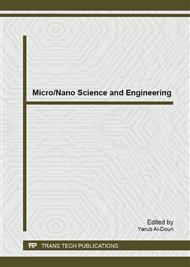p.33
p.38
p.43
p.48
p.52
p.57
p.62
p.67
p.72
Zeolite Supported Ionic Liquid Catalyst for the Synthesis of Nano-Cellulose from Palm Tree Biomass
Abstract:
Nanocellulose promises to be a very versatile material having wide range of biomedical and biotechnological applications including tissue engineering, drug delivery, wound dressings, medical implants, food, cosmetics, paper and textiles. The current methods for the synthesis of nanocellulose involve harsh chemical treatments which are perpetually hazardous to human and environment. Catalytic synthesis of nanocellulose might be a green approach. Among the various types of catalyst, ionic liquids, which are composed of both cations and anions and have low or negligible vapor pressure, are particularly promising. Ionic liquids also exhibit a relatively wide electrochemically stable window, good electrical conductivity, high ionic mobility, a broad range of room temperature liquid compositions, selective dissolvability to many organic and inorganic materials, and excellent chemical and thermal stabilities. In contrast, zeolite catalysts have been used in petroleum refineries for the removal of sulfur. Zeolite catalysts are also important for the synthesis of bulk chemicals, fine and specialty chemicals, fuels and chemicals. Acidic and metal modified micro porous zeolite catalysts have been used in several commercial processes in petroleum industry, fuel components, abatement of exhaust gas emissions and biomass upgrading, pharmaceutical and fine chemical industries. Currently, zeolite catalysts are synthesized in powder form and to make them industrially useful, such catalysts have to be mixed with a binder and formulated in different shapes. This paper reviewed the introduction, preparation, synthesis and application of nanocellulose from lignocellulosic palm biomass.
Info:
Periodical:
Pages:
52-56
Citation:
Online since:
April 2014
Authors:
Keywords:
Price:
Сopyright:
© 2014 Trans Tech Publications Ltd. All Rights Reserved
Share:
Citation:


